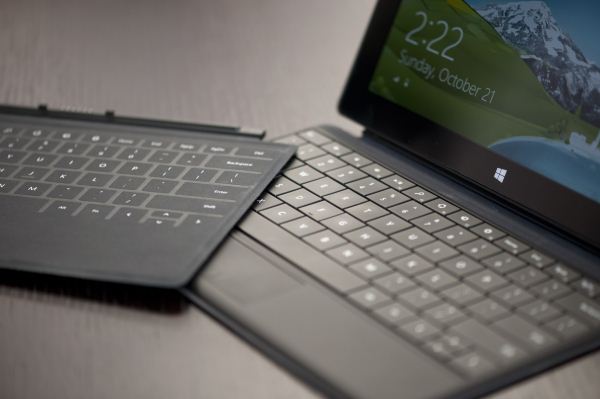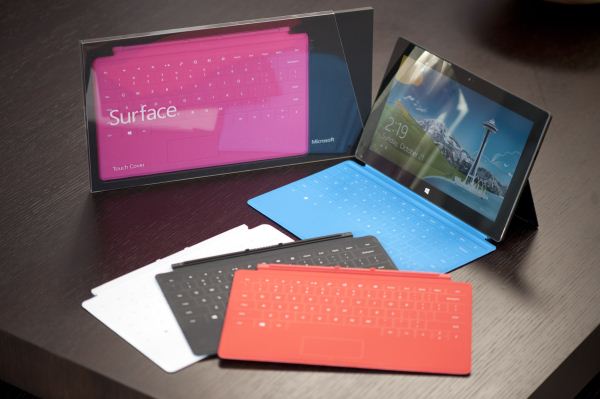Microsoft Surface Review
by Anand Lal Shimpi on October 23, 2012 9:01 PM EST- Posted in
- Tablets
- Microsoft
- Mobile
- Surface
- Windows RT
Pricing and Final Words
Last week Microsoft announced pricing for Surface. The base configuration starts at $499 with 32GB of internal storage, you can get a bundle with a black Touch Cover for $599 and finally there’s a 64GB model with Touch Cover for $699. All versions of Surface come with Office 2013 Home & Student Edition preview, and will be upgraded (for free) to the final build of Office 2013 once it’s available.
Whether or not Surface is priced appropriately really depends on how much you value Windows RT and getting Office 2013 for free. I suspect if you’re already a big Office user, you’ll see a lot of value in the bundle. On the Windows RT side, whether or not that platform has value really depends on how frustrated you are by the multitasking, task switching and lack of screen sharing (two apps on the screen at once) of other mobile OSes. Depending on your feelings on those two issues Surface will either feel like a bargain, or too much.
As a device, Surface is incredibly well executed. It makes sense that Microsoft’s OEM partners are feeling the pressure as there’s very little that I would change about Surface from a design perspective. The chassis is well built and the integrated kickstand is seriously one of the most useful features to ever meet a tablet. The optional Touch and Type Covers complete the package. While a full sized notebook is going to deliver a better typing experience, when paired with its Touch/Type covers Surface results in a more productive platform than any other tablet.
Surface is the most flexible tablet I've ever used. Through two seemingly simple additions to the design (but incredibly complex to actually develop and implement), Microsoft took a tablet and turned it into something much more. If you're frustrated by productivity limits of currently available tablets, Surface really seems to be the right formula for a solution. It's important to note that Microsoft's execution with Surface establishes the company as a competitive powerhouse in the mobile design market. I can only imagine what multiple revs of the design will give us, not to mention what could happen if Microsoft set its obsessive sights on smartphones or notebooks.
The Windows RT experience, in many senses, is clearly ahead of what many competitors offer in the tablet space today. Multitasking, task switching and the ability to have multiple applications active on the screen at once are all big advantages that Microsoft enjoys. For productivity workloads, Surface is without equal in the tablet space.
Content consumption is also great on the device. Surface's display isn't industry leading but it's still good. Reading emails, browsing the web flipping through photos and watching videos are all good fits for the platform - just as good as competing solutions from Apple or Google.
More impressive than the fact that Microsoft brought competitive parity to the Windows tablet usage model is the fact that power efficiency doesn't seem to be an issue for Windows RT. Microsoft has built a mobile OS that is capable of, at least based on what we've seen today with Surface, being competitive with Android and iOS solutions when it comes to battery life. With lower power silicon inside, Microsoft could do even better.
I don't believe Surface is perfect, but it's a platform I can believe in. What I'm most excited about is to see what happens after a second or third rev of the design. I would have liked to have seen faster hardware inside (I'd love to see an Atom based version). There are also some rough edges that could use smoothing out (e.g. the power connector and HDMI output come to mind) and Windows RT likely needs another round of updates (app launch times are far too long, more apps needed) but overall the device is easily in recommendable territory. The biggest issue I have with recommending Surface today is that you know the next iteration of the device is likely going to be appreciably better, with faster/more efficient hardware and perhaps even a better chassis.
If you're ok being an early adopter, and ok dealing with the fact that mobile devices are still being significantly revved every year, Surface is worth your consideration. If you've wanted a tablet that could begin to bridge the content consumption and productivity divide, Surface is it.












235 Comments
View All Comments
Shadowmaster625 - Wednesday, October 24, 2012 - link
Doesnt it bother you that simply typing a vanilla document in Office uses so much cpu power. You think they are ever going to fix that? What happens when you give it access to much more cpu resources? Will it simply consume it all?andrewaggb - Wednesday, October 24, 2012 - link
Both Anand and Vivek said it keeps up though, which is the main thing I think. And these are guys who type for a living. Really it drives home that anything slower than tegra 3 wouldn't cut it and tegra 3 is barely fast enough.As for what happens when you give it more cpu, how does word run on your current desktop? On my first gen core i7 laptop (dual core), I can get word up to 4% cpu in task mgr by key bashing.
I'd be very interested in seeing what battery life and video performance an atom based tablet gets.
robmuld - Wednesday, October 24, 2012 - link
The choice of 16:9 for the display just tells me Microsoft will never get itN4g4rok - Wednesday, October 24, 2012 - link
Have you looked at the Pro version spec sheet?WP7Mango - Wednesday, October 24, 2012 - link
Actually, Microsoft DO get it. There are 3 reasons why 16:9 is preferable -1. It allows for the Windows 8 / RT multitasking feature - two apps snapped side by side, with one app taking up a thin column whilst the other app taking up a larger portion. These can be swapped round just by dragging the seperator between them. Even the desktop can be snapped with a metro app this way. It's an elegant solution to multitasking on a tablet, and a feature that the iPad doesn't have.
2. It's the ideal size for watching movies whilst minimising black borders.
3. The extra horizonal screen space gives you more flexibility in terms of app UI capabilities.
ET - Wednesday, October 24, 2012 - link
I think it's a pity that Microsoft doesn't allow running .NET apps on the desktop interface. That would have made Window RT comparable to Windows 8 and allowed using the Surface as a full PC, with a decent choice of software already available.jamawass - Wednesday, October 24, 2012 - link
Interesting review. Does the usb port support cameras? Can pictures be transferred from a camera to the surface as on a desktop?WP7Mango - Wednesday, October 24, 2012 - link
Yes, the USB port does support cameras. Yes, pictures can be transferred from a camera to the Surface just like you can on a desktop PC.karasaj - Wednesday, October 24, 2012 - link
I don't know if you're still answering questions Anand (or any staff) but do you think Surface RT would suffice for a university student who just needs to rapidly type on Microsoft office for ~50 minutes without it feeling sluggish at all? That and streaming netflix are probably all that I need to do with Surface, if I can do that, then I'd pay for surface over an ultrabook (i.e. vizio ct14-a0) for the portability and battery life.B3an - Thursday, October 25, 2012 - link
I think Surface would be the best option for that kind of stuff. It's perfectly suited for it. My brother is at uni and wants the same kind of thing, and he's getting a Surface.